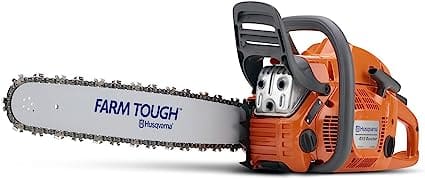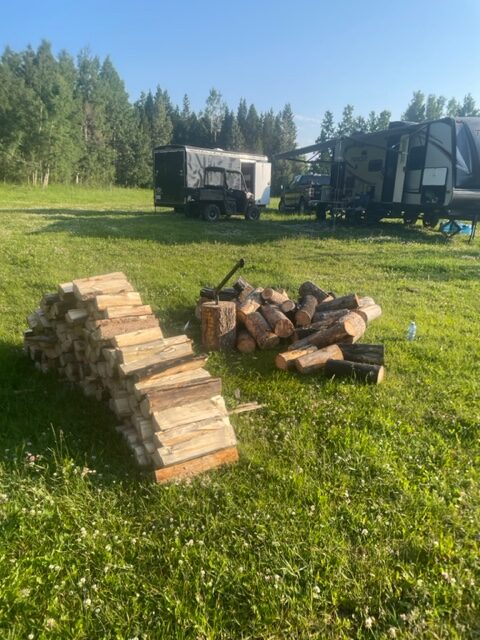
🌟 Featured Product for Cutting Firewood on Public Land in Alberta 🌟
I. Introduction
Harvesting firewood on public land in Alberta requires knowledge of the regulations and responsible practices to ensure the health and sustainability of the forests. In this guide, we’ll discuss firewood collection during camping trips, how to identify dead-standing trees, precautions to take while harvesting, and the types of softwood firewood suitable for outdoor use.
II. Firewood Collection During Camping Trips
A. Personal Use Forest Products Permit (PUFPP)
The PUFPP is not intended to collect firewood during camping trips. When random camping on vacant crown land, a permit to cut firewood for your campsite is optional. If you plan to bring wood home that you cut on public land, you need a permit.

III. Identifying Dead Standing Trees
A. Tips for spotting dead trees
- Look for trees without leaves or needles, even during the growing season.
- Check for brittle branches that snap easily.
- Examine the bark for signs of decay, such as peeling or missing sections.
- Search for evidence of insect infestation, such as woodpecker holes or sawdust piles at the base of the tree.
IV. Precautions for Harvesting Firewood
A. Safety measures
- Wear appropriate protective gear, such as gloves, eye protection, and sturdy boots.
- Use a sharp, well-maintained chainsaw or handsaw.
- Ensure you have a clear escape path when felling a tree.
- Be aware of your surroundings and avoid harvesting near power lines, buildings, or other hazards.
B. Environmental considerations
- Only harvest dead standing trees, leaving live trees to continue growing.
- Avoid cutting trees near water sources, as they provide important habitat and help prevent erosion.
- Do not disturb trees that are providing habitat for wildlife, such as nesting birds or cavity-dwelling animals.
V. Types of Softwood Firewood for Outdoor Recreational Use
Softwood firewood types vary in their burning characteristics, making some more suitable for specific uses than others. Here’s a closer look at each type, including how to recognize them, what to expect when burning them in a campfire, and stand-out details for identifying dead standing trees:
A. Low-Quality Softwood Firewood
Ideal for outdoor camping firewood:
- Poplar Firewood:
- Recognition: Poplar trees have smooth, greenish-grey bark when young, which turns into thick, rough, and dark-colored bark as they age. The leaves are roughly triangular with a pointed tip and serrated edges.
- Stand-out details for dead standing: Dead standing poplars may have large sections of bark missing, exposing the lighter-colored wood underneath. The branches may be brittle and easily broken.
- Burning characteristics: Poplar firewood burns quickly with a relatively low heat output, making it suitable for short campfires or kindling. It can produce more smoke and creosote than other types of wood and may leave a significant amount of ash.
- External website for image reference: Gettyimages.ca – Poplar Trees
- Spruce Firewood:
- Recognition: Spruce trees have sharp, square-shaped needles that grow individually along the branches. The bark is thin and scaly, often flaking off in small, circular patches. Cones are elongated and hang downwards from the branches.
- Stand-out details for dead standing: Dead standing spruce trees may have an overall grey appearance, with needles and branches missing. The bark may be loose or peeling away in patches.
- Burning characteristics: Spruce firewood also burns quickly with a low heat output, similar to poplar. It can produce a lot of creosote and sparks, making it more suitable for outdoor use. Spruce firewood may leave a moderate amount of ash after burning.
- External website for image reference: Gettyimages.ca- Dead Standing Spruce Trees
B. Mid-Quality Softwood Firewood
Suitable for recreational use:
- Pine firewood, such as Lodgepole Pine Firewood:
- Recognition: Lodgepole pine trees have long, slender needles in bundles of two. The bark is thin, flaky, and dark brown to black. Cones are small, egg-shaped, and may have a slight curve.
- Stand-out details for dead standing: Dead standing lodgepole pines may have a greyish color and missing or sparse needle coverage. The bark may be loose or have large cracks running vertically along the trunk.
- Burning characteristics: Pine firewood, including lodgepole pine, burns with a moderate heat output and can produce a pleasant aroma. It ignites easily, making it great for kindling or starting a campfire. Pine firewood can produce a moderate amount of creosote and ash, so it’s best to use it outdoors or in well-maintained chimneys.
- External website for image reference and more info: Gettyimages.ca- Lodgepole Pine Trees
By familiarizing yourself with the recognition and stand-out details of dead-standing trees and using the provided external websites for image references and more information, you can more easily identify and harvest the appropriate type of softwood firewood for your outdoor campfires.
VI. Recommended Products for Processing Firewood
To safely and efficiently process firewood, it’s essential to have the right tools and equipment. Here’s a list of recommended products to help you get the job done:
- Chainsaw: A chainsaw is an essential tool for cutting firewood. Choose a reliable, well-reviewed model from a reputable brand like Stihl, Husqvarna, or Echo. Consider factors such as your experience, the size of the wood you’ll be cutting, and your budget when selecting a chainsaw. We recommend Husqvarna 455 Rancher Gas Chainsaw.
- Axe: A good-quality axe is useful for splitting logs and kindling. Look for one with a sturdy handle made of hickory or fiberglass and a sharp, durable head. Popular brands include Fiskars, Estwing, and WilFiks. We recommend WilFiks Chopping Axe, 36” Camping Outdoor Hatchet for Wood Splitting and Kindling.
- Hardhat and face shield: Personal protective equipment is crucial when working with chainsaws and axes. A hardhat with a built-in face shield will protect your head and face from flying debris and potential accidents. We recommend the TR Industrial Forestry Safety Helmet and Hearing Protection System.
- Safety chaps: Chainsaw safety chaps are designed to protect your legs from potential chainsaw injuries. They are made from layers of cut-resistant material and are essential when using a chainsaw. We recommend the Husqvarna 587160704 Technical Apron Wrap Chap.
- Boots: Sturdy, protective boots with good ankle support and slip-resistant soles are crucial for safety while working with chainsaws and axes. Steel-toe boots provide additional protection. We recommend the Timberland PRO Men’s Pitboss 6″ Steel-Toe Boot.
- Chainsaw chains: Keep extra chainsaw chains on hand, as they can become dull or damaged during use. Choose chains compatible with your chainsaw model and ensure they are the correct size and type for your cutting needs. We recommend 8TEN Semi Chisel Chainsaw Chain 20 Inch.
- Chainsaw chain sharpener: A sharp chain is essential for efficient cutting. Invest in a chainsaw chain sharpener to keep your chains in top condition. Options include manual sharpeners, like files and guides, or electric models for faster, more precise sharpening. We recommend Stihl 2-in-1 Easy File Chainsaw Chain Sharpener.
- Chain oil: Regularly lubricating your chainsaw chain with chain oil is essential for optimal performance and longevity. Choose a high-quality bar and chain oil to keep your chainsaw running smoothly. We recommend Husqvarna X-Guard Premium All Season Bar & Chain Oil.
- Fuel: Gas-powered chainsaws require a mix of gasoline and 2-cycle engine oil for proper operation. Keep an appropriate fuel mix on hand and follow your chainsaw manufacturer’s guidelines for the correct ratio. We recommend Husqvarna Pre-Mixed 2-Stroke Fuel and Engine Oil.
By investing in the right tools and equipment, you can process firewood safely and efficiently. Always follow the manufacturer’s guidelines for use, maintenance, and safety precautions to ensure a successful and enjoyable firewood cutting experience.
VII. Conclusion
By following the guidelines in this comprehensive guide to firewood harvesting on public land in Alberta, you can ensure a responsible and enjoyable outdoor experience. Remember to adhere to the regulations and harvest firewood in a manner that promotes the health and sustainability of Alberta’s forests.
Thanks for Visiting: Explore More on SunnyDaysGo
Thank you for checking out How To Cut Firewood on Public Land in Alberta. We appreciate your interest!
Explore More Articles:
Exploring Alberta Public Land Use Zones: Your Ultimate Guide to Outdoor Adventures
Discover the diverse outdoor activities available in Alberta’s Public Land Use Zones. Learn about the best spots for hiking, camping, and wildlife viewing.
How To Striking a Balance in Public Land Use Zones Alberta
Find out how to balance recreation and conservation in Alberta’s Public Land Use Zones. Understand the guidelines and tips for responsible land use.
Camping on Crown Land in Alberta: Your Ultimate Guide
Learn everything you need to know about camping on Crown land in Alberta. This guide covers regulations, best practices, and top camping spots.
Conservation Initiatives in Alberta’s Public Land Use Zones (PLUZs)
Explore the conservation efforts in Alberta’s Public Land Use Zones. Understand the initiatives aimed at preserving the natural beauty and biodiversity of these areas.
Alberta Fly Fishing Report: Discover the Best Spots and Techniques
Get the latest fly fishing report for Alberta. Learn about the best fishing spots, techniques, and seasonal tips to enhance your fishing experience.
We hope you find these articles helpful and informative. Don’t forget to share them with your friends and family!
